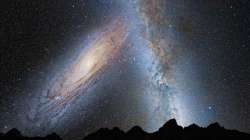Heart of Milky Way devoid of any young stars, claims study
A huge region around the centre of the Milky Way galaxy is devoid of young stars, claims a new study. "The current results indicate that there has been no significant star formation in this large

A huge region around the centre of the Milky Way galaxy is devoid of young stars, claims a new study.
"The current results indicate that there has been no significant star formation in this large region over hundreds of millions years," said one of the study authors Giuseppe Bono from University of Rome Tor Vergata in Italy.
"The movement and the chemical composition of the new Cepheids are helping us to better understand the formation and evolution of the Milky Way," Bono noted.
The Milky Way is a spiral galaxy containing many billions of stars with our Sun about 26,000 light years from its centre.
Measuring the distribution of these stars is crucial to our understanding of how our Galaxy formed and evolved.
Pulsating stars called Cepheids are ideal for this. They are much younger (between 10 and 300 million years old) than our Sun (4.6 billion years old) and they pulsate in brightness in a regular cycle.
The length of this cycle is related to the luminosity of the Cepheid, so if astronomers monitor them they can establish how bright the star really is, compare it with what we see from Earth, and work out its distance.
Despite this, finding Cepheids in the inner Milky Way is difficult, as the Galaxy is full of interstellar dust which blocks out light and hides many stars from view.
The team of researchers led by professor Noriyuki Matsunaga of University of Tokyo compensated for this, with an analysis of near-infrared observations made with a Japanese-South African telescope located at Sutherland, South Africa.
To their surprise they found hardly any Cepheids in a huge region stretching for thousands of light years from the core of the galaxy.
"Our conclusions are contrary to other recent work, but in line with the work of radio astronomers who see no new stars being born in this desert," study co-author Michael Feast from University of Cape Town in South Africa, noted.
The findings were published in the journal Monthly Notices of the Royal Astronomical Society.
(With inputs from IANS)